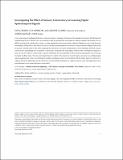Investigating the effect of sensory concurrency on learning haptic spatiotemporal signals
Abstract
A new generation of multimodal interfaces and interactions is emerging. Drawing on the principles of Sensory Substitution and Augmentation Devices (SSADs), these new interfaces offer the potential for rich, immersive human-computer interactions, but are difficult to design well, and take time to master, creating significant barriers towards wider adoption. Following a review of the literature surrounding existing SSADs, their metrics for success and their growing influence on interface design in Human Computer Interaction, we present a medium term (4-day) study comparing the effectiveness of various combinations of visual and haptic feedback (sensory concurrencies) in preparing users to perform a virtual maze navigation task using haptic feedback alone. Participants navigated 12 mazes in each of 3 separate sessions under a specific combination of visual and haptic feedback, before performing the same task using the haptic feedback alone. Visual sensory deprivation was shown to be inferior to visual & haptic concurrency in enabling haptic signal comprehension, while a new hybridized condition combining reduced visual feedback with the haptic signal was shown to be superior. Potential explanations for the effectiveness of the hybrid mechanism are explored, and the scope and implications of its generalization to new sensory interfaces is presented.
Citation
Carson , I , Quigley , A , Clarke , L & Hinrichs , U 2021 , ' Investigating the effect of sensory concurrency on learning haptic spatiotemporal signals ' , Proceedings of the ACM on Interactive, Mobile, Wearable and Ubiquitous Technologies , vol. 5 , no. 1 , 6 , pp. 1-30 . https://doi.org/10.1145/3448102
Publication
Proceedings of the ACM on Interactive, Mobile, Wearable and Ubiquitous Technologies
Status
Peer reviewed
ISSN
2474-9567Type
Journal article
Collections
Items in the St Andrews Research Repository are protected by copyright, with all rights reserved, unless otherwise indicated.

